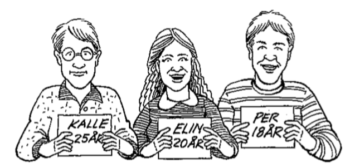Good, Better, Bäst! Comparing Adjectives – The Irregulars Posted by Chelsea B on Aug 14, 2020 in Grammar, Swedish Language, Vocabulary
Two posts ago, I covered comparative adjectives – happy, happier, happiest, remember? This essential grammar concept allows you to mention your younger cousin, older sister, or the best ice cream place in town. This week we’ll move to the irregular adjectives in their comparative form, but don’t worry, there are patterns here, too! Okej, nu kör vi!
If this concept is new for you – Stanna! Stop right there! Read this post first to learn more about this concept. If that feels good, great, you’re ready to learn the irregulars. Let’s grow your vocabulary, from Stor, to Större! You may even become Bäst someday. (See how I managed to weave music into this post too? 😉 )
The irregular adjectives often change their first vowel when shifting from positiv to komparativ. For example, we swap a “u” for a “y” here:
tung → tyngre → tyngst
heavy → heavier → heaviest
We still see the -re ending to the komparativ form, as well -st, and -sta with superlative obestämd and bestämd. Remember, we use the superlativ bestämd form when we’re talking about “the best hotdog stand in Stockholm /Den bästa korvkiosken i Stockholm.”
Note that a few adjectives change their root entirely. For example:
gammal → äldre → äldst
old → older → oldest
Below are some examples from a chart via Lär dig svenska’s blog, another fabulous resource for all things Swedish grammar! Review the forms, then practice with the examples below:
| Positiv | Komparativ | Superlativ | |
| Obestämd | Bestämd | ||
| låg | lägre | lägst | lägsta |
| dålig | sämre | sämst | sämsta |
| hög | högre | högst | högsta |
| stor | större | störst | största |
| lång | längre | längst | längsta |
| liten/små | mindre | minst | minsta |
| ung | yngre | yngst | yngsta |
| bra/god | bättre | bäst | bästa |
| gammal | äldre | äldst | äldsta |
| nära | närmare | närmast | närmaste |
| tung | tyngre | tyngst | tyngsta |
| lång | längre | längst | längsta |
| mycket | mer | mest | mesta |
| många | fler | flest | flesta |
1. lång (here lång means “tall”)
Lasse är 170 cm. Anna är 178 cm. Christian är 180 cm.
Anna är _______ än Lasse, men Christian är _______.
Anna is taller than Lasse, but Christian is tallest.
2. stor
Danmark är 42 959 km2. Sverige är 528 447 km2. Ryssland är 17 098 242 km2.
Sverige är _______ än Danmark, men Ryssland är _______.
Sweden is larger than Denmark, but Russia is largest.
3. liten
Sverige är _______ än Ryssland, men Danmark är _______.
Sweden is smaller than Russia, but Denmark is smallest.
4. hög
Akka är 2 016 meter. Sarektjåkkå är 2 089 meter. Kebnekaise är 2 104 meter.
Sarektjåkkå är _______ än Akka, men Kebnekaise är_______.
Sarektjåkkå is higher than Akka, but Kebnekaise is highest.
5. låg
Sarektjåkkå är _______ än Kebnekaise, men Akka är _______ .
Sarektjåkkå is lower than Kebnekaise, but Akka is lowest.
6. liten
Hunden är _______. Katten och råttan är _______ än hunden. Råttan är ________ av de tre djuren.
The dog is small. The cat and the rat are smaller than the dog. The rat is smallest of the three animals.
7. ung
Kalle är _______. Elin och Per är ______ än Kalle. Per är ______ av syskonen Boman.
Kalle is young. Elin and Per are younger than Kalle. Per is youngest of the Boman siblings.

Build vocabulary, practice pronunciation, and more with Transparent Language Online. Available anytime, anywhere, on any device.








Comments:
Duncan:
I’ll just add a link to another very helpful post from this blog about the two different ways of saying “worse” and “worst” in Swedish: https://blogs.transparent.com/swedish/thats-just-the-worst-in-swedish/
Chelsea B:
@Duncan Yes, that’s a great segue to this post. Tack för sharing!